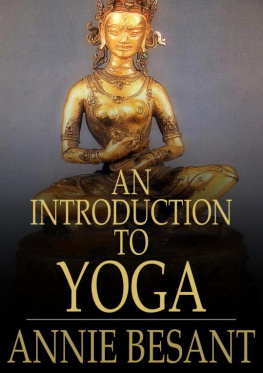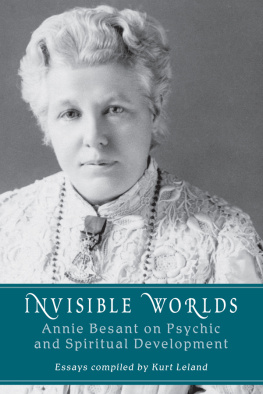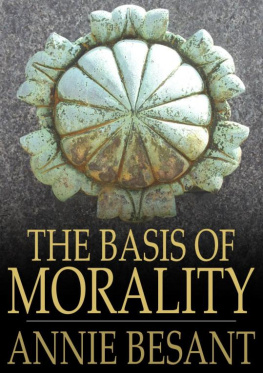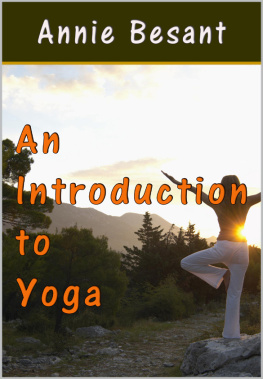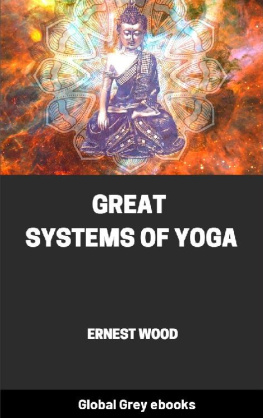Annie Wood Besant - An Introduction to Yoga
Here you can read online Annie Wood Besant - An Introduction to Yoga full text of the book (entire story) in english for free. Download pdf and epub, get meaning, cover and reviews about this ebook. City: Waiheke Island, year: 2009, publisher: The Floating Press, genre: Religion. Description of the work, (preface) as well as reviews are available. Best literature library LitArk.com created for fans of good reading and offers a wide selection of genres:
Romance novel
Science fiction
Adventure
Detective
Science
History
Home and family
Prose
Art
Politics
Computer
Non-fiction
Religion
Business
Children
Humor
Choose a favorite category and find really read worthwhile books. Enjoy immersion in the world of imagination, feel the emotions of the characters or learn something new for yourself, make an fascinating discovery.
- Book:An Introduction to Yoga
- Author:
- Publisher:The Floating Press
- Genre:
- Year:2009
- City:Waiheke Island
- Rating:3 / 5
- Favourites:Add to favourites
- Your mark:
- 60
- 1
- 2
- 3
- 4
- 5
An Introduction to Yoga: summary, description and annotation
We offer to read an annotation, description, summary or preface (depends on what the author of the book "An Introduction to Yoga" wrote himself). If you haven't found the necessary information about the book — write in the comments, we will try to find it.
An Introduction to Yoga — read online for free the complete book (whole text) full work
Below is the text of the book, divided by pages. System saving the place of the last page read, allows you to conveniently read the book "An Introduction to Yoga" online for free, without having to search again every time where you left off. Put a bookmark, and you can go to the page where you finished reading at any time.
Font size:
Interval:
Bookmark:
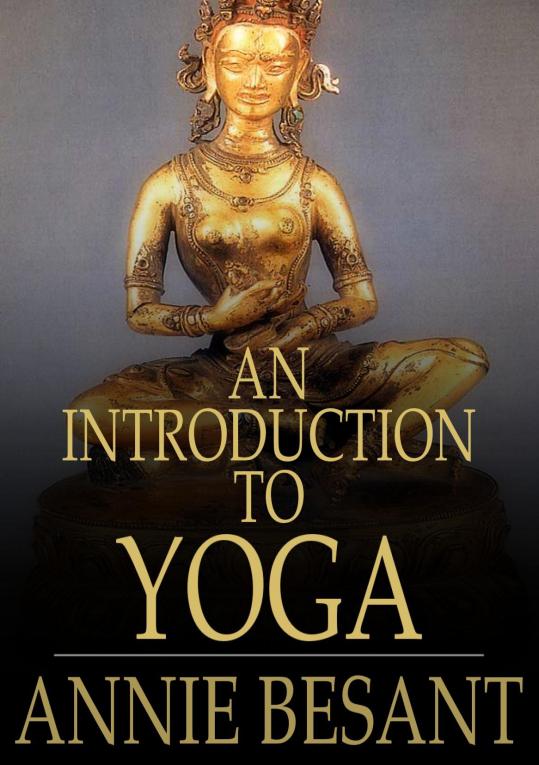

An Introduction to Yoga
From a 1907 edition.
ISBN 978-1-775414-13-1
2009 THE FLOATING PRESS.
While every effort has been used to ensure the accuracy and reliability of the information contained in The Floating Press edition of this book, The Floating Press does not assume liability or responsibility for any errors or omissions in this book. The Floating Press does not accept responsibility for loss suffered as a result of reliance upon the accuracy or currency of information contained in this book. Do not use while operating a motor vehicle or heavy equipment. Many suitcases look alike.
Visit www.thefloatingpress.com
These lectures Toprepare the student for the mastering of that more difficulttask, these lectures were designed; hence the many references toPatanjali. They may, however, also serve to give to the ordinarylay reader some idea of the Science of sciences, and perhaps toallure a few towards its study.
Annie Besant
In this first discourse we shall concern ourselves with thegaining of a general idea of the subject of Yoga, seeking itsplace in nature, its own character, its object in humanevolution.
Let us, first of all, ask ourselves, looking at the world aroundus, what it is that the history of the world signifies. When weread history, what does the history tell us? It seems to be amoving panorama of people and events, but it is really only adance of shadows; the people are shadows, not realities, thekings and statesmen, the ministers and armies; and the eventsthe battles and revolutions, the rises and falls of states arethe most shadowlike dance of all. Even if the historian tries togo deeper, if he deals with economic conditions, with socialorganisations, with the study of the tendencies of the currentsof thought, even then he is in the midst of shadows, the illusoryshadows cast by unseen realities. This world is full of formsthat are illusory, and the values are all wrong, the proportionsare out of focus. The things which a man of the world thinksvaluable, a spiritual man must cast aside as worthless. Thediamonds of the world, with their glare and glitter in the raysof the outside sun, are mere fragments of broken glass to the manof knowledge. The crown of the king, the sceptre of the emperor,the triumph of earthly power, are less than nothing to the manwho has had one glimpse of the majesty of the Self. What is,then, real? What is truly valuable? Our answer will be verydifferent from the answer given by the man of the world.
"The universe exists for the sake of the Self." Not for what theouter world can give, not for control over the objects of desire,not for the sake even of beauty or pleasure, does the GreatArchitect plan and build His worlds. He has filled them withobjects, beautiful and pleasure-giving. The great arch of the skyabove, the mountains with snow-clad peaks, the valleys soft withverdure and fragrant with blossoms, the oceans with their vastdepths, their surface now calm as a lake, now tossing infurythey all exist, not for the objects themselves, but fortheir value to the Self. Not for themselves because they areanything in themselves but that the purpose of the Self may beserved, and His manifestations made possible.
The world, with all its beauty, its happiness and suffering, itsjoys and pains" is planned with the utmost ingenuity, in orderthat the powers of the Self may be shown forth in manifestation.From the fire-mist to the LOGOS, all exist for the sake of theSelf. The lowest grain of dust, the mightiest deva in hisheavenly regions, the plant that grows out of sight in the nookof a mountain, the star that shines aloft over us-all these existin order that the fragments of the one Self, embodied incountless forms, may realize their own identity, and manifest thepowers of the Self through the matter that envelops them.
There is but one Self in the lowliest dust and the loftiest deva."Mamamsaha"My portion," a portion of My Self," says SriKrishna, are all these Jivatmas, all these living spirits. Forthem the universe exists; for them the sun shines, and the wavesroll, and the winds blow, and the rain falls, that the Self mayknow Himself as manifested in matter, as embodied in theuniverse.
One of those pregnant and significant ideas which Theosophyscatters so lavishly around is thisthat the same scale isrepeated over and over again, the same succession of events inlarger or smaller cycles. If you understand one cycle, youunderstand the whole. The same laws by which a solar system isbuilded go to the building up of the system of man. The laws bywhich the Self unfolds his powers in the universe, from thefire-mist up to the LOGOS, are the same laws of consciousnesswhich repeat themselves in the universe of man. If you understandthem in the one, you can equally understand them in the other.Grasp them in the small, and the large is revealed to you. Graspthem in the large, and the small becomes intelligible to you.
The great unfolding from the stone to the God goes on throughmillions of years, through aeons of time. But the long unfoldingthat takes place in the universe, takes place in a shortertime-cycle within the limit of humanity, and this in a cycle sobrief that it seems as nothing beside the longer one. Within astill briefer cycle a similar unfolding takes place in theindividual rapidly, swiftly, with all the force of its pastbehind it. These forces that manifest and unveil themselves inevolution are cumulative in their power. Embodied in the stone,in the mineral world, they grow and put out a little more ofstrength, and in the mineral world accomplish their unfolding.Then they become too strong for the mineral, and press on intothe vegetable world. There they unfold more and more of theirdivinity, until they become too mighty for the vegetable, andbecome animal.
Expanding within and gaining experiences from the animal, theyagain overflow the limits of the animal, and appear as the human.In the human being they still grow and accumulate withever-increasing force, and exert greater pressure against thebarrier; and then out of the human, they press into thesuper-human. This last process of evolution is called "Yoga."
Coming to the individual, the man of our own globe has behind himhis long evolution in other chains than oursthis same evolutionthrough mineral to vegetable, through vegetable to animal,through animal to man, and then from our last dwelling-place inthe lunar orb on to this terrene globe that we call the earth.Our evolution here has all the force of the last evolution in it,and hence, when we come to this shortest cycle of evolution whichis called Yoga, the man has behind him the whole of the forcesaccumulated in his human evolution, and it is the accumulation ofthese forces which enables him to make the passage so rapidly. Wemust connect our Yoga with the evolution of consciousnesseverywhere, else we shall not understand it at all; for the lawsof evolution of consciousness in a universe are exactly the sameas the laws of Yoga, and the principles whereby consciousnessunfolds itself in the great evolution of humanity are the sameprinciples that we take in Yoga and deliberately apply to themore rapid unfolding of our own consciousness. So that Yoga, whenit is definitely begun, is not a new thing, as some peopleimagine.
Font size:
Interval:
Bookmark:
Similar books «An Introduction to Yoga»
Look at similar books to An Introduction to Yoga. We have selected literature similar in name and meaning in the hope of providing readers with more options to find new, interesting, not yet read works.
Discussion, reviews of the book An Introduction to Yoga and just readers' own opinions. Leave your comments, write what you think about the work, its meaning or the main characters. Specify what exactly you liked and what you didn't like, and why you think so.

